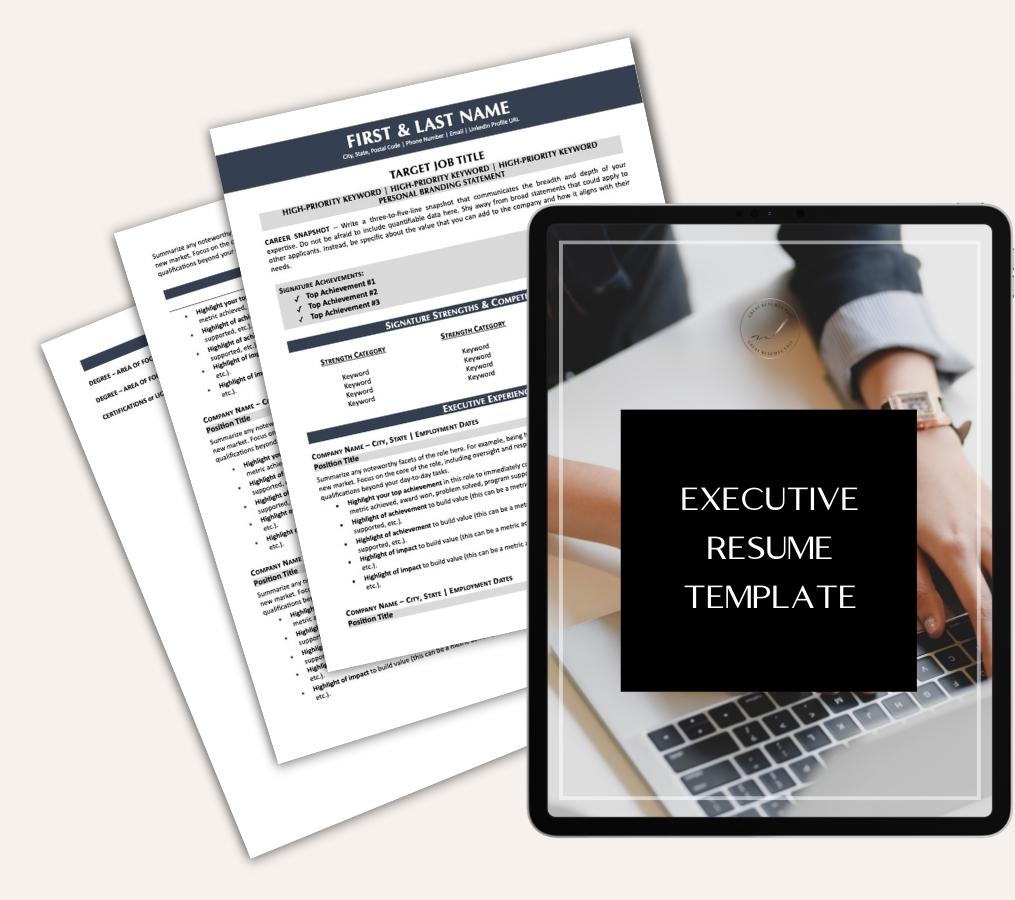6 Tips for a Visually Engaging CEO Resume
Competing at the top level isn’t easy. When you’re being considered for a Chief Executive Officer position, you’re likely up against some stiff competition. If you want to be sure you’re considered for the executive position you deserve, you’re going to have to make sure that you have an executive resume that’s engaging, compelling, and powerful.
‘What is the best format for an executive resume?’ is a question that gets posed often—and with good reason. How you present your experience, skills, and qualifications visually can affect how you are perceived and understood—and paid attention to—as an executive job applicant. To make resume writing and applying to executive positions easier, you might be tempted to find some free CEO resume templates online. Let me advise you, though—this is not a good idea. Using a resume template and just filling in the blanks won’t let you effectively convey your career experience, and it will likely be obvious to the hiring manager or recruiters that you just took a resume template off the internet and filled it in. Not good. Especially not good for a prospective C-level executive.
Here’s the good news, though! When it comes to formatting an executive resume to make it visually appealing, it’s the simple touches that make a difference—so here are a few suggestions:
Remember the White Space
Often, in the drive to provide as much information as possible in a couple of pages (no, you should not have a one-page resume as an executive), the importance of white space is forgotten during the resume writing process. White space actually draws the eye in to the content, so be sure that your resume has wide margins (at least an inch) all around. If you look at the resume examples that are available on the Great Resumes Fast website, you’ll notice a decent amount of white space.
As a potential Chief Executive Officer, you’re getting one shot among many—so make sure your resume is professional and attractive. Position your heading at least one and a half inches down from the top—so the reader’s eye is drawn in.
Metrics are Critical
Figures are imperative in an executive resume. You want to show the board of directors, the hiring manager, the recruiter (basically anybody who might care) how you’re going to favorably impact the bottom line for the business, so talk about operational spending, cost savings, and budget allocations to show achievements that can be quantified. Think about every highlight of your career and ask: “How much?” Quantify project budgets, staff numbers, time savings, and ROI. Be sure to include these notable achievements in your career summary. Any that really stand out may also be worth mentioning in your cover letter.
And, speaking of your career summary—just because it is called a summary statement doesn’t mean it should be a “general overview” of your career and work history. This is by far one of the most critical parts of your resume. A CEO resume summary statement needs to be compelling! If you capture the hiring manager’s attention in the first third of the resume, he or she will be more inclined to continue reading.
Use Color
Using color in the text and in the background can emphasize your achievements. Use it to highlight words, and identify key points. Make sure the color you use is in line with your industry; as an example, using the hot new color of the season (even if it’s neon pink) may be great if you’re looking for a position in the fashion industry, but not so much if you’re applying for a job with an IT-focused business.
Be Bold!
When writing a CEO resume (or any professional resume, really), you want to avoid text-heavy paragraphs where nothing really stands out. So use bold text to highlight the points that you really want noticed. This is particularly useful if you’re trying to guide the reader’s eye to specific technical skills, leadership roles, accomplishments, or particularly relevant work experience that may actually be text-heavy. Just pick out certain words and phrases that are important—and bold them. Statistics, percentages, and other metrics are usually the safest bet for executive resumes—and the most important ones you want to draw attention to anyway.
Visual Elements
It might sound obvious, but be sure to space out sections. A CEO resume is likely to have a lot of information, and no one wants to read a bunch of jumbled-together paragraphs. The hiring process can be arduous enough without tiny fonts crammed into lengthy paragraphs.
Here’s what you do—separate the critical elements. Use a bit of white space between job descriptions, and to separate employment from education, and so on. It helps with the flow, and guides the reader’s eye down to the next section. Use shading, charts, graphs, and text callouts to bring attention to important pieces of information that you don’t want the reader to miss. Have particular skills or strengths that were mentioned in the job description and can help to set you apart from other candidates. Use the format of your resume to bring attention to them! Using testimonials and quotes is also a great way to substantiate your brand in the eye of the company.
Be a Great Storyteller
When writing a resume, essentially, what you’re trying to do is tell the story of your career. People love to read a great story—so to land the CEO position you want to make your resume captivating. Think of the books and magazine articles that you find enjoyable, and use the same techniques to tell your own story. Would you enjoy a plot that was just a bulleted list of the character’s duties and responsibilities and not a compelling description of their most impressive accomplishments? Then human resources and the board of directors won’t, either. Don’t just list your work experience in a dull way! Show what you’ve accomplished. You can also use color, spacing, and bold type occasionally to engage the reader—and make him or her want to keep on reading—and then want to learn more about you at an interview. Remember—you’re marketing yourself with your resume!
Want more CEO resume tips and advice on how to create a resume that stands out and gets you interviews? Check out the Great Resumes Fast blog. Here we share our expertise with hundreds of articles with resume writing tips and general career advice.
If you’re looking for a sample CEO resume to provide some inspiration, visit our resume sample page where you’ll find executive resume examples that may provide you with ideas and motivation for writing your resume.
If you’re ready to work with a professional executive resume writer to craft your CEO resume, the team at Great Resumes Fast is ready to help you. Learn more about our resume writing team here, and learn more about our resume writing services for CEOs here.
Are you tired of your resume being rejected by applicant tracking systems? I know how frustrating it is to submit your resume and receive no response. I hate seeing qualified people never break through the screening process. It shouldn’t be that way. That’s why I created this guide and I encourage you to download the FREE PDF so you can start seeing better resume response rates!
Share this post:

About the author
Jessica Hernandez, President, CEO & Founder of Great Resumes Fast
Hi, I’m Jessica. I started this company back in 2008 after more than a decade directing hiring practices at Fortune 500 companies.
What started as a side hustle (before that was even a word!) helping friends of friends with their resumes has now grown into a company that serves hundreds of happy clients a year. But the personal touch? I’ve kept that.
You might have seen me featured as a resume expert in publications like Forbes, Fast Company, and Fortune. And in 2020, I was honored to be named as a LinkedIn Top Voice of the year!
I’m so glad you’re here, and I can’t wait to help you find your next perfect-fit position!
Improve Your Resume: Download Your Free Executive Resume Template Today
Are you struggling to create an executive resume that will impress employers? Download this free executive resume template and receive a series of 10 emails with expert guidance on how to write resume content that resonates with employers so you get more interviews.
It's everything you need to stand out, make an impression, and accelerate your job search.








